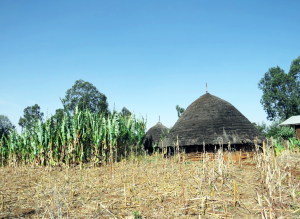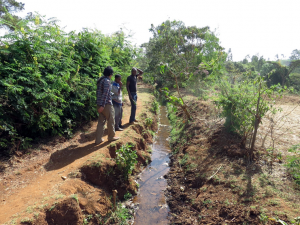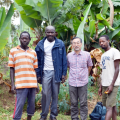
Ethiopia Report
Focusing on impressions of rural landscapes in the southern regions of Ethiopia
Kyoto University
Professor of The Center for African Area Studies
Jun Ikeno
I toured Ethiopia between February 18 and March 1, 2016. The main objective of the trip was to explain the aims of the Brain Circulation Program to university staff members in the capital city of Addis Ababa, the southern city of Arba Minch and Awassa—and to request their future cooperation. The secondary purpose was to gather information about rural areas, in order to understand the paradigm shift in the conventional wisdom of regular people in Ethiopia.
We left on the night of February 18, flying with Emirates Airlines from Kansai International Airport and arrived in Addis Ababa on the afternoon of February 19. Soon after arriving, we visited Addis Ababa University, which was the main counterpart of the Brain Circulation Program in Ethiopia. We met Professor Gebre Yntiso at Department of Social Anthropology, and were able to confirm that Professor Yntiso, an old friend of the researchers (and a former Kyoto University Visiting Professor, in regular contact with the University), will actively participate in the Brain Circulation Program. The following day, we had an opportunity to meet Professor Yntiso and engage in a meaningful dialogue about Ethiopia as a case study.
We tried to meet Professor Adane Mekkonen from the Awassa University Department of Sociology on February 21. On February 24, we met with Professor Feleke Woldeyes, the President of Arba Minch University, and Professor Yohannes Yitobarek, the Director of the Arba Minch University’s South Omo Research Center in Jinka City. We made the same request as to Professor Yntiso and they all very kindly accepted. Prof. Woldeyes, President of Arba Minch University was particularly enthusiastic; he has stayed in Japan as a Visiting Fellow at Kyoto University and has close connections with Japanese researchers, including Professor Shigeta. Addis Ababa University is well established, having been founded in 1950. By contrast, Awassa University was founded in 2000 (although previously opened in 1976) and Arba Minch University in 1986; both are young universities engaged in infrastructure development, but also with a feeling of vibrant activity.
While carrying out our primary objective, we also pursued the secondary objective of broadening our knowledge of agricultural communities in southern Ethiopia. We visited relatively distant rural areas surrounding Awassa City—the rural town of Woliso (the standard orthography for Woliso is not fixed; we saw the alternative spellings, “Waliso” and “Woloso” on public facilities) and its neighboring village, Gaagle (G-village). This is the area studied by Dr. Toshikazu Tanaka, who took his doctoral degree from the Graduate School of Asian and African Area Studies at Kyoto University. We asked Mr. Tanaka to accompany us and he acted as our guide.
Photo 1: G-village house and agricultural field
Photo 1 shows a traditional house and an agricultural field where enset, teff, maize and catha are being cultivated. In premises, the head of the household, several of his wives and other family members, including married sons, were all living in separate houses. We got the impression that the crops had been meticulously planted in these agricultural fields. Dr. Tanaka explained that catha was traded every morning from about 6 a.m. to 8:30 a.m. and shipped to places such as Addis Ababa. Catha leaves must be fresh. G-village is only a few hours from Addis Ababa, so this area has a geographical advantage. Catha grows and can be cultivated throughout the year, enabling many G-village families to earn cash every day. The bars become crowded as soon as work finishes in the morning. We felt that it would be interesting to investigate whether catha was a desirable cash crop, and how people felt their income from catha should be spent.
Photo 2: A small-scale irrigation facility in G-village
Harvesting catha all year round is made possible by a constant water supply provided by small-scale irrigation facilities, such as the one shown in Photo 2. The popularity of catha cultivation has grown rapidly during the last 10 years, although the small-scale irrigation facilities were actually built 70–80 years ago for enset, one of the staple crops. Although water is not very abundant, individual households do not need large quantities of irrigation water, and there is no competition for water resources. Moreover, communal water sources have been installed, enabling local people to ladle water into plastic containers and carry it to their homes.
From February 25–27, we traveled to rural areas that surround the city of Arba Minch. Arba Minch (meaning “40 lakes”) features an expansive lakes and an abundant supply of water. It is located in a somewhat with high temperatures. As a result, there are vast groves of bananas, as shown in Photo 3. These bananas are cultivated for raw consumption, but we couldn’t determine whether they were for domestic consumption in cities such as Addis Ababa or—in addition—used for trade. Got the impression that, when needed, vast farmlands that looked moist and fertile could still be used to cultivate staple crops.
After leaving Arba Minch City we had an opportunity to visit Konso City, Jinka City and Metser Village. Between Arba Minch City and Konso City we saw the unique sloped agricultural fields shown in Photo 4. Moringa (Moringa oleifera) trees spread out below the hillside farms.
Photo 3: Vast banana groves arround Arba Minch City
Photo 4: Hillside farming and moringa trees between Arba Minch and Konso
There were large space between the trees, and we occasionally saw traces of the maize harvest. It is possible that this land was used for agro-forestry. Several small trucks were parked nearby; their drivers were buying moringa leaves. Dr. Tanaka told us that much of the demand for this product is due to its value as a leaf vegetable. Around 1990, moringa was introduced as a new crop to the Mwanga District in the Kilimanjaro Region of northern Tanzania, my area of study. At the time, it was considered an oil crop; the beans inside the pods were used but the leaves were not. Although the varieties introduced in this region of Ethiopia and in northern Tanzania may be different, we felt it was important to highlight its use as a leafy vegetable in Tanzania.
The areas around Konso already enjoy worldwide renown; they feature unique terraced fields.
Photo 5: Houses and terraced fields surrounding Konso
The terraced hillside in Photo 5 is made from stone; the construction of such fields is labor intensive. A traditional house with a double thatched roof can be seen in the upper living area. It is clearly very different from the house in Photo 1. We were able to see the preservation of remarkably specific architectural styles in each region. In northern Tanzania, traditional houses with thatched roofs and circular walls have been replaced by ones with corrugated metal roofs and square walls. Although dense groups of traditional houses are often labeled “poor family houses” in Tanzania, it was our strong impression that these were being carefully preserved, as a part of the regional culture in Ethiopia.
We visited Arba Minch University’s South Omo Research Center (Photo 6) in Jinka City and met with its director, Professor Yohannes Yitobarek, whom we had previously seen at the University. A museum at this research center housed exhibitions of material culture from various ethnic groups in southern Ethiopia. We wondered whether many tourists would make the effort to travel the considerable distance from Addis Ababa to Jinka, but even during our visit, four carloads of Westerners arrived. Although there were lodgings attached to the research center for study tours, there was not enough water for domestic use. For example, we saw toilets that couldn’t be flushed; it is unfortunate that these facilities have been neglected.
Photo 6: View of the South Omo Research Center (photograph from the back yard of the main office)
Photo 7: Enset Nursery Site staff (Metser village)
We traveled further beyond Jinka and visited the Enset Nursery Site (Photo 7) in Metser Village. Professor Shigeta, who traveled with us, played a central role in developing this facility, which preserves enset varieties; he has collaborated with local communities over many years. Many enset varieties are cultivated here, and people are taught to produce handicrafts using enset textiles. Enset is cultivated as a staple crop even in G-village (Photo 1), and can be seen extensively in the southern regions of Ethiopia. We hope that these efforts to promote the use and conservation of enset, thus preserving the ecology, will continue into the future.
The above is a report on my trip to Ethiopia between February 18 and March 1, 2016. We reconfirmed cooperative relationships with researchers at Addis Ababa University and with other specialists involved with the Brain Circulation Program; we also gained significant knowledge about the regional diversity and potential of the rural landscapes of southern Ethiopia.
















